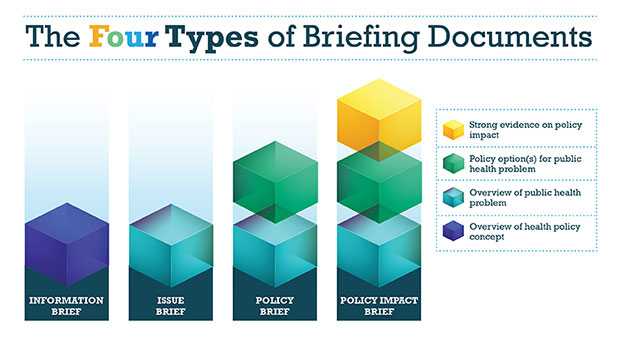Resources for Writing Briefs

Policy is an important tool for improving population health. Decision makers often look to public health professionals for surveillance data, research findings, and evidence-based interventions and guidelines to help inform policy decisions. CDC has identified four types of briefing documents that can be used to clearly communicate public health evidence. Public health professionals can use the resources below to develop briefs that succinctly inform decision makers and stakeholders of the best available evidence on a public health problem, policy, method, or approach.
Accelerating Science Impact: Four Types of Briefing Documents
The four types of briefing documents can be used to share evidence and inform decisions at every stage of the CDC Policy Process. Selecting the appropriate brief depends on the level of the evidence available and the stage in the policy process. As research evidence grows and more information becomes available, public health professionals can move from an Issue Brief on the public health problem up to a Policy Impact Brief on the potential health, economic, or budgetary impact of a policy. All four brief types are described below.
- An Information Brief provides a summary of the research on a policy method, approach, or other related topic like behavioral economics or the Health in All Policies approach.
- An Issue Brief provides a summary of the best available evidence on a public health problem with policy implications. An issue brief is most appropriate when no policy solutions are known to exist and the issue is still in the problem identification domain of the policy process.
- A Policy Brief builds on an issue brief by providing a summary of evidence-based best practices or policy options for a public health problem. A policy brief is appropriate for issues in domains two, three, four and five of the policy process: policy analysis, strategy and policy development, policy enactment, and policy implementation respectively.
- A Policy Impact Brief is the most in-depth briefing document and provides a summary of the best available evidence on health, economic, or budgetary impact of one or more policies for a public health problem. A policy impact brief is appropriate when evaluations and evidence exist on the health or economic impact of the policy.
Steps for Writing
When you’re ready to start developing your brief, consider the following steps.
- Identify your key audience. Potential audiences may be those who inform policy at the federal, state, or local level; federal, state, local, or nongovernmental decision makers; or other stakeholders.
- Conduct audience research. In order to translate the evidence in a way that is easy to understand, get to know your audience. Don’t guess or assume. Review data or, when possible, gather new data through formative research.
- Determine your purpose and make sure your material contains one obvious main message.
- Develop content for the type of brief you want to create.
- Define and explain terms that may be unfamiliar to your audience. Avoid using jargon or technical terms unless absolutely necessary.
- Organize information into chunks with headings.
- A “chunk” is the amount of words or numbers people can hold in their short-term memory and group with other words or numbers. A chunk should be only one idea that people can connect to other, related ideas.
- Use headings to organize and label chunks.
- Use bulleted or numbered lists to break up text in the body of the material and make information easier to scan and read. Lists with more than seven items should be broken into sub-lists.
- Review the CDC Clear Communication Index for other tips on communicating clearly with your intended audiences.
- Include at least one visual aid that conveys or supports the main message. Photographs, graphs, and infographics are visual aids. Simple, well-designed visual aids help people easily and quickly grasp information. Make sure words and visual aids convey the same message and reinforce each other.
- Include considerations for the key audience. Be clear about what the evidence might mean (as it relates to the issue at hand) but also what it might not mean (if relevant), and frame the evidence in a way that is accurate and easy for the audience to understand.
- Format your brief. Finally, your brief should be concise, compelling, and visually appealing to your audience.
- Page last reviewed:January 18, 2017
- Page last updated:January 18, 2017
- Content source:


 ShareCompartir
ShareCompartir